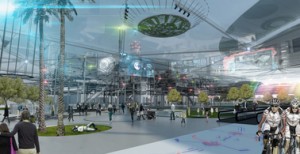View Source | February 26, 2014
 How will Phoenix’s future urban spaces emerge, and what might these scenarios mean for environmental, economic and social sustainability? Senior Sustainability Scientist Darren Petrucci and School of Sustainability alumnus Rider Foley presented one tool for answering such questions at the “New Tools for Science Policy” breakfast seminar, hosted by ASU’s Consortium for Science, Policy and Outcomes (CSPO) in Washington, D.C. on Feb. 28.
How will Phoenix’s future urban spaces emerge, and what might these scenarios mean for environmental, economic and social sustainability? Senior Sustainability Scientist Darren Petrucci and School of Sustainability alumnus Rider Foley presented one tool for answering such questions at the “New Tools for Science Policy” breakfast seminar, hosted by ASU’s Consortium for Science, Policy and Outcomes (CSPO) in Washington, D.C. on Feb. 28.
Their technology works by mapping Phoenix’s trajectory and determining how it came to be the city it currently is. “From there, we could begin to extrapolate where the urban form and growth might go,” says Petrucci. Keeping in mind the forces that underlie technology’s interplay with urban evolution - including competing desires like economic growth, access to clean water, security, and the sustainable use of natural resources – they created visualization scenarios in video format. These scenarios encourage viewers to consider their current decisions and how they may impact the future.

